|
|
Ancient Broken Beauties
The philosophy of Wabi Sabi, the
art of Kintsugi & broken words of the Sufi
We are all broken, Poe
There is nothing more human than that.
Kovacs in dialogue with AI, Poe.
Quote from the Serial,
Altered Carbon.
To protect yourself from
the rising flood of fake beads, consider this advice:
Pursue the 'Broken Beauties'.
You will not find any counterfeits bearing the deep
cracks and scars that come with age and use. Every
replica is created with a deceptive illusion of
perfection, as that is the aesthetic preferred by
collectors from China. Ironically, in their quest for
authenticity, these forgers may sometimes introduce
superficial flaws to make their work appear more
convincing.
This insight can be your armor, shielding you from
deceit in the world of ancient beads. Your appreciation
for imperfections can serve as a touchstone for
authenticity, ensuring that the beads you invest in are
genuine artifacts, not merely convincing replicas.
Let me tell you a story.

Mount Kailash
Reflections on Bead
Imperfections
Mount Kailash, a revered site for pilgrims, is located
in the Tibetan region, neighbored by two distinct lakes
that hold contrasting symbolism.
Mansarovar,
often associated with divinity, is considered the lake
of the Gods, while
Rakshas Tal,
shrouded in negative connotations, is deemed the lake of
the Demons. Consequently, devout pilgrims only
circumambulate Mansarovar, deliberately shunning Rakshas
Tal.
Paradoxically, the once-pristine Mansarovar now lies
polluted, its beauty marred by the detritus left behind
by the ever-increasing hordes of ignorant pilgrims. The
lake has become a victim of its own popularity.
Conversely, Rakshas Tal, being devoid of pilgrim
activity, remains immaculate and stunning. The irony of
the situation is palpable.
A parallel can be drawn between the story of these lakes
and the scenario faced by ancient beads in today's
market. Chinese collectors often associate imperfect
ancient beads, those with cracks or scars, with bad
luck, thus avoiding them. As a result, unblemished,
perfect beads are skyrocketing in value due to intense
demand, while flawed beads, untouched by the voracious
appetite of the market, remain relatively affordable. In
the shadow of this disproportionate interest, the
overlooked "imperfect" beads retain their original
charm, untouched by the 'garbage of greed'.
To unearth the truth
behind counterfeit beads, tracing the money provides
insightful clues. Pristine, perfect beads are often
targeted for imitation,
simulacra,
while the so-called 'bad luck' beads, marred by their
flaws, paradoxically possess a heightened sense of
authenticity in the wake of this trend.
In many respects, Ancientbead.com mirrors a pilgrimage
around Rakshas Tal, the untouched lake of the Demons. I
cherish beads with flaws, not merely because they are
more affordable, but due to the profound connection they
inspire. These scarred beads resonate with my own life's
journey - a path that doesn't aim for flawless
perfection. If perfection crosses my path, I appreciate
its presence, but my fundamental pursuit is to embrace
the perfection inherent in imperfection. With that in
mind, I dedicate this ode to our flaw-marked beads and
to life's beautifully imperfect journey. You can read
more about this by clicking on the picture below:
A PRAISE TO THE SCARRED BEAD
...and a praise to C. G. Jung
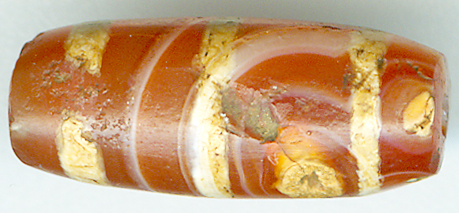
Often the scars, wear, and tear of time
contributes directly to the beauty of a bead. Calcification is one of
the clearest signs of true age. The calcification on this elongated
Indus bead below has a marvelous almost translucent shine.
|
|
|

BB
1 - 56
* 11 mm
|
|
Wabi Sabi & Sufi
Wabi-Sabi (侘寂) is an integral philosophy within
Japanese culture, deeply rooted in Zen Buddhism. It
focuses on the aesthetics of the 'perfectly imperfect,'
symbolizing a profound acceptance of life's inherent
imperfections and transience, to the extent of revering
them aesthetically.
As Wiki puts it, the wabi-sabi aesthetic include asymmetry,
roughness, simplicity, economy, austerity, modesty,
intimacy, and appreciation of the ingenuous integrity of
natural objects and processes. Seen through a
Western lens, one might compare this concept to the
philosophical principle of 'amor fati '
- love of one's fate.
Specifically, in Zen Buddhism, where there is no
singular personal deity, worship transforms into a deep
admiration for the existential human condition as
defined by the 'three marks of existence.' These are:
三法印
Sanbōin:
Impermanence (無常 Mujō)
Suffering (苦 Ku)
Emptiness or the absence of self-nature (空 Kū)
One might suggest that
Japanese Zen Buddhism offers a resolution to the
existential stages posited by philosopher Søren
Kierkegaard. Kierkegaard outlined three stages of life -
the aesthetic, the ethical, and the religious. However,
Zen Buddhism seems to add a fourth stage, looping back
to the aesthetic phase but situating it within a
transhuman context, yet maintaining a deeply personal
religious and ritualized setting for worship. In this
sense, even a mundane act such as sipping a cup of tea
transforms into a deeply significant, almost spiritual,
act of reverence — a ritual conducted within a framework
that transcends traditional religious dogmas.
Octavated Aestheticism
This octavated aestheticism manifests in a unique form
of religiousness, devoid of any rigid religious doctrine
or moral constraints. This concept shares a striking
similarity with the realm of the Sufis, where not
everyday objects, but poetry becomes the ineffable
medium of understanding what the dualistic ordinary mind
cannot comprehend. A Zen koan propounds, "If you meet
Buddha on the road, kill him." This signifies the notion
that any conceptualization of the Buddha falls short of
the true essence. In a parallel sentiment, the esteemed
Sufi poet Rumi says, "Out beyond ideas of wrongdoing and rightdoing there is a field. I'll meet you there." This
evokes the understanding that the true nature of
existence lies beyond dualistic concepts of right and
wrong. Both philosophies exhort us to transcend our
regular frameworks of perception to experience the
profound depths of existence.
This aesthetic reverence
for the imperfect, transient, and incomplete starkly
contrasts the modern, rigid, and nouveau riche Chinese
perspective of perfection. Nonetheless, it's essential
to remember that Zen Buddhism originated in mainland
China, and today's China is among the places in the
world undergoing rapid cultural evolution. The era of
one-dimensional bead sellers and collectors from China
is waning, because in these times of transformative
change, the old English adage, "It takes three
generations to make a gentleman," no longer holds true.
Progress is much swifter than that.
I've recently observed a burgeoning generation of
Chinese youth demonstrating socio-emotional aptitude far
exceeding what is typically seen among the more
self-oriented and hedonistic youth of the West. I
apologize for these sweeping generalizations; they are
intended merely to incite a bit of thoughtful
introspection among Western readers, rather than paint a
definitive picture of either culture. It's not uncommon
for us in the West to jest at the ways of the emerging
affluent in the East. Yet, such laughter has echoed
throughout history, anywhere rapid societal change and
progression have occurred. If this youthful cohort from
Wuhan is indicative of the future, they might not even
reciprocate our laughter down the line. They might
possess the poise to refrain from such reactions.
|
|
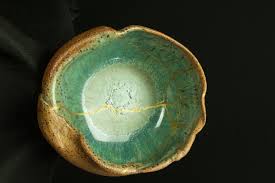 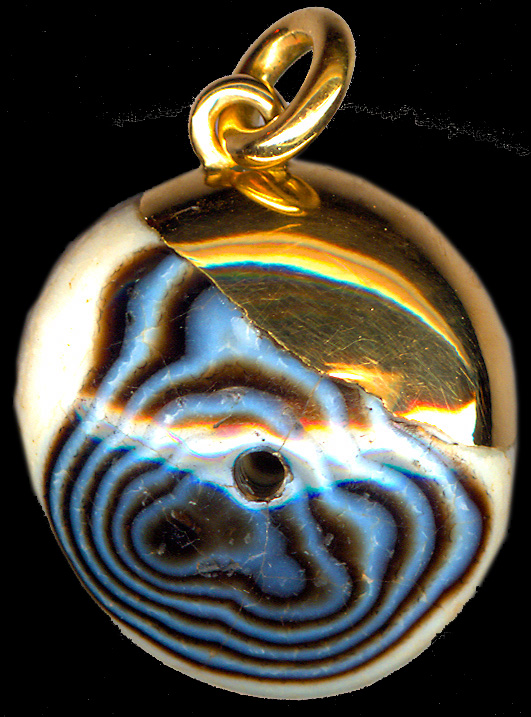
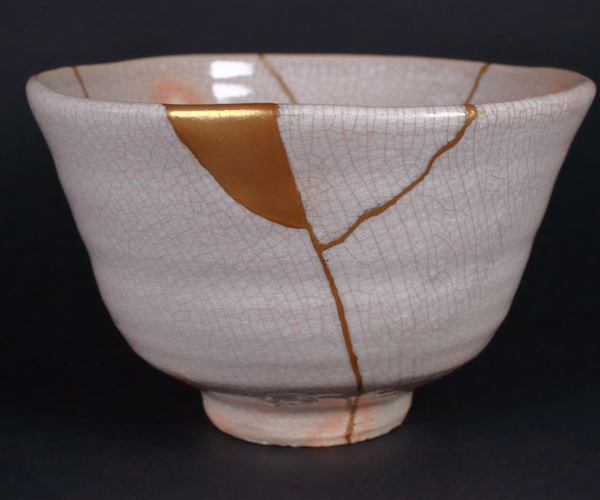
The wound is the
place where the Light enters you.
Rumi
|
|
Kintsugi Beads
Take a look at the artwork in the middle image above,
created by Danish goldsmith
Bodil Binner.
It vividly demonstrates how a fractured bead's beauty
can be rekindled through a golden restoration.
Kintsugi
is essentially the art of Wabi Sabi manifested in the
golden repair of pottery, as depicted in the above
illustration. Christy Bartlett perfectly encapsulates
the essence of Kintsugi with this quote:
"There is not only no effort to hide the damage, but
the repair is literally illuminated... a kind of
physical expression of the spirit of mushin....Mushin is
often literally translated as 'no mind,' but carries
connotations of fully existing within the moment, of
non-attachment, of equanimity amid changing conditions.
...The vicissitudes of existence over time, to which all
humans are susceptible, could not be clearer than in the
breaks, the knocks, and the shattering to which ceramic
ware too is subject. This poignancy or aesthetic of
existence has been known in Japan as mono no aware, a
compassionate sensitivity, or perhaps identification
with, [things] outside oneself." - Christy Bartlett,
Flickwerk: The Aesthetics of Mended Japanese Ceramics -
quoted from Wikipedia
These ancient Japanese concepts translate almost
seamlessly into the bead philosophy of Ancientbead.com.
In the case of a bead's artistic reconstruction, one
could regard it as an inspirational adaptation of the
Japanese Kintsugi.
What's generally perceived as an imperfection, like the
chipped off ends of the beads displayed below, is often
considered detrimental to the bead's overall beauty
score. However, these damages at the top do not mar the
overall impression of the beads' strikingly beautiful
bodies. The beads could be adorned with gold caps at the
top, enabling them to radiate even more resplendently
than in their original form, thereby enhancing their
Kintsugi score.
|
|
|
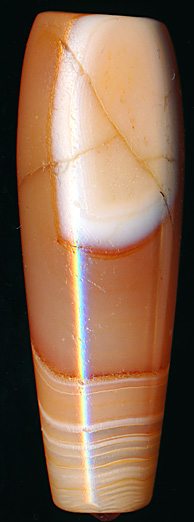
BB 2
- 33 * 10,5 mm
|

BB
3 - 38
* 9 mm
|
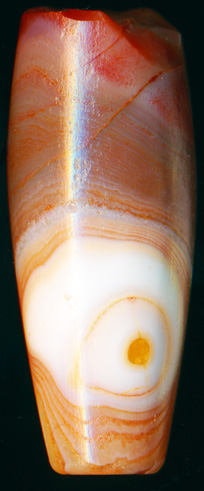
BB
4 -
31 * 12 mm
|
|
Don't be satisfied with stories,
how things have gone with others.
Unfold your own myth.
Rumi
|
|
Are we not ourselves full of cracks trusting life
to remake us in a golden remake?
|
|
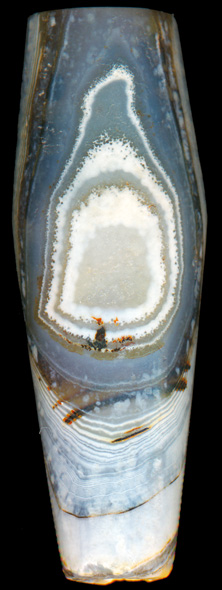
BB 5
- 36 * 13 mm
|

BB
6 - 36
* 11 mm
|
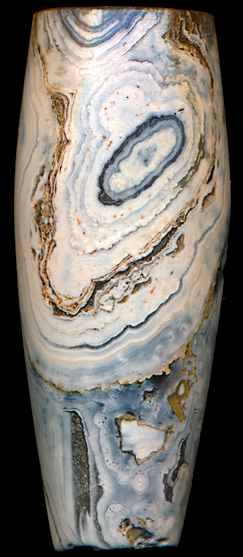
BB
7 - 35
* 14
mm
|
|
Indeed, we are all like
beads, riddled with cracks and imperfections as a result of the
vicissitudes of life. Yet, it's through these cracks and
imperfections that we trust life to transform us, to mend us
with metaphorical gold, making us stronger, more resilient, and
even more beautiful in our imperfection. In essence, each of us
is on a continuous journey of personal Kintsugi.
|
|
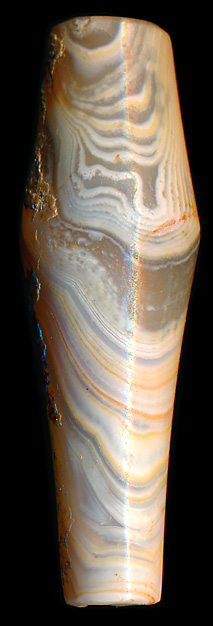
BB
8 - 39 * 11,5 mm
|

BB
9 - 41
* 10
mm
|

BB
10 - 40
* 8 mm
|
|
|
|
Dance, when you're broken open. Dance, if
you've torn the bandage off.
Dance in the middle of the fighting. Dance in your blood.
Dance when you're perfectly free.
Rumi
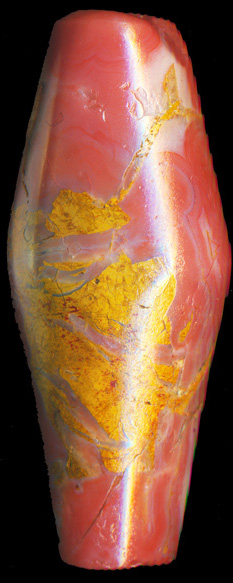
BB
11 -
36 * 14 mm
|
|
THE ARTISTRY OF FLAWS
By this point, the message should be clear: from my
Western meta-modern perspective, a bead does not need to be flawless to be
captivating. In fact, I often find myself more enamored with a
scarred bead than a perfect one.
The Lens of the West
I view beads through a Western lens. Unlike a
professional, my Western gaze may not be trained to distinguish
a genuine bead from a fake within seconds. However, this lens
might be more unspoiled and naive, potentially allowing it to
appreciate aspects that a professionally trained eye may
overlook.
Could it be possible that the proverbial "Emperor of
Asian Beads" is in fact naked? Are all our judgments and
preferences merely protective garments shielding us from the
harsh reality of impermanence? As I see it, our perspectives are
made from the stuff of dreams, appearing real only within an
echo chamber that creates a socially constructed,
intersubjective reality.
I am acquainted with an Austrian bead collector who
refuses to buy perfect beads. Why? Because his father was an
archaeologist. To him, perfection in beads is an aberration.
If your view of beads is primarily
as an investment, similar to "bit-beadcoins," it's inevitable
that your perspective will be narrow. This category of Asian
collectors, generally speaking, lacks a grounding in historical
and archaeological knowledge. In many ways, they resemble the
modern ultra-wealthy collector of contemporary art. For these
individuals, provenance
often plays an increasingly vital role because they have minimal
interest or knowledge about the actual art piece they're
acquiring; it's viewed merely as an investment.
But let's return to the realm of ancient beads. I don't
claim to be an expert. I also appreciate nearly perfect beads.
However, imperfections and scars are secondary factors in my
selection process. If a bead boasts captivating colors,
symmetries, forms, and shapes, I prioritize these
characteristics above all else.
When I study the patterns within a bead, I perceive
sacred geometry. These humble beads never attended university.
Their creators were not literate either. Yet, the patterns abide
by universal laws of mathematics and geometry.
Thus, the ancient bead serves as a reminder that the
world isn't solely dictated by mindless chaos. The chaos is as
intelligent as the cosmos itself; it's simply a form of
intelligence we have yet to fully comprehend.
The pursuit of absolute perfection
can often be perilous, especially when it becomes collectively
ingrained in political thought. It mirrors a totalitarian
mindset. On a personal level, too, the quest for perfection
often proves unhealthy. I imagine some of you, dear readers,
have had similar reflections on this matter. I view the aged,
scarred bead as a fitting metaphor for my own self. Despite my
age and scars, there remains in me a steadfast belief in
Kalos
Kai Agathos, the beautiful, good, and just.
Please don't misunderstand me. I cherish perfect beads as
well, but only when they form an integral part of a mosaic made
up of perfectly imperfect beads.
|
|
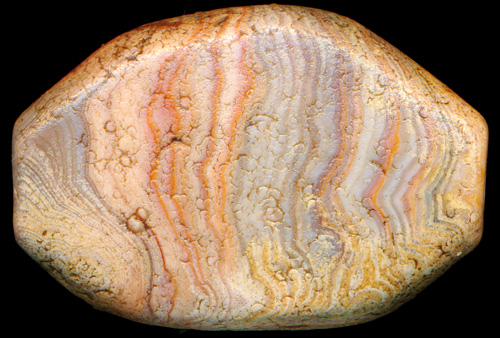
BB
12 -
31 * 21 * 8 mm
In all
chaos there is a cosmos,
in all disorder a secret order.
C. G. Jung
|
|
Dragon Marks or Mandalas: Symbols of Transformation
The intriguing circular markings, frequently observed on ancient
beads, are likely the result of rapid temperature fluctuations
acting upon the stone material. These weathering imprints, or dragon
mark circles as they are poetically referred to in the
realm of DZI, seem to effortlessly craft a captivating tableau
when juxtaposed with the exceptionally thin, parallel,
multicolored layers of the bead.
The term "dragon marks" itself invites the weaving of tales,
stirring up the imagination with evocative imagery. Yet, it also
invites one to delve deeper, to consider the symbolic
implications. Drawing upon the profound work of Carl Gustav
Jung, I propose another interpretation: seeing these circles as
mandalas.
In Jungian psychology, mandalas are symbolic
representations of the self in its entirety, embodying the
concept of harmony and wholeness. They are the psychic
manifestation of the individual's striving for unity, both
within oneself and with the greater cosmos. So perhaps, these
natural patterns, these dragon
marks or mandalas on the beads, could symbolize a primal,
universal yearning for integration and completeness, for
balancing the dualities that dwell within us and in the world
around us. This reading could add another layer of meaning, a
psychological and spiritual dimension, to the aesthetic and
material aspects of ancient bead art.
|
|
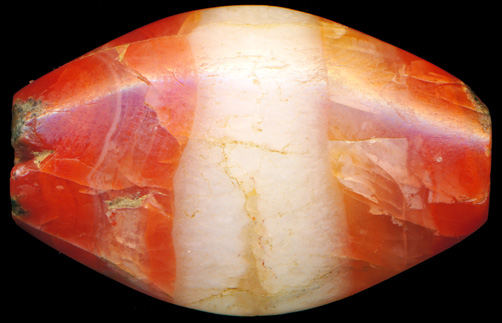
BB
13 -
31 * 20 *
7,5 mm
Forget safety. Live where you fear to live.
Destroy your reputation.
Be notorious.
Rumi
|
|
Let me weave for you a tale
This tale will carry us on a voyage of imagination back to
the birthplace of civilization. Let us first explore the
weathered Indus Valley bead you saw bove.

It bears the marks of
extensive use and the passage of time. Now, let's trace the
delicate, irregular lines of varying thickness that run through
its surface and deep within. Observing these marks of age and
use, it's not hard to grasp a self-evident truth: this ancient
artifact is older than any of us. It carries a rich history that
stretches back 5,000 years. However, this history is only
sparked into life - or perhaps more accurately, called forth -
when it encounters an observer. In my consciousness, each tiny
crack unfurls a narrative, a chapter of its past.
Perhaps the bead gained one of its wrinkles from tumbling off a
worn-out string. Other cracks might have formed during a
millennium spent under the relentless pressure of the soil. Yet
another line could be the result of rapid temperature shifts –
from the frosty chill on an Afghan mountain slope one day, to
the blazing sun the next. Other fractures developed over
centuries due to varying kinds of micro pressure. Maybe the bead
was part of a string where the beads jostled each other or
rubbed against the spacers that separated them. Interactions
with soil, air, skin, clothing, and perhaps even a decomposing
body in a grave left their indelible mark in the form of lines,
patina, and calcification. Some of the more recent cracks may
have been inflicted by a digger's shovel, and later, when this
bead met other ancient beads in the pocket of the person who
unearthed them. Then they ended up in a box in Bangkok, where I
excitedly rummaged through them, causing them to collide once
more. |
|
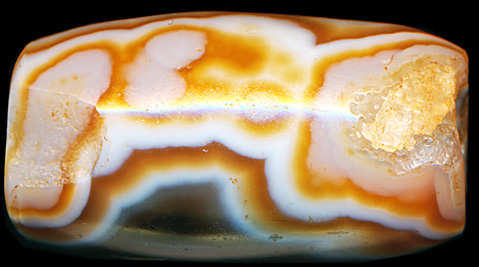
BB
14 -
30 * 17 mm
Sell your cleverness and buy bewilderment.
Rumi
|
|
The Prequel to the Tale
The agate stone with its swirling motifs is essentially birthed
in the heart of volcanoes. The spiraling, curling, and circular
patterns found in this ancient Indus bead convey a tale of
volcanic drama that precedes the bead's existence. The
crystalline scar to the right was a part of the stone even
before it was shaped into a bead, most likely formed in the
seething cauldron of molten rock that was its birthplace. Why
did the craftsman decide to incorporate this apparent
imperfection into the design of the bead? It's possible that it
was initially hidden beneath a thin layer of agate, only
revealed after a millennium of usage wore it down.
This instance reflects the raw, authentic beauty of the material
used, baring its raw history and ancient origins. The craftsman,
rather than discarding or disguising these perceived 'flaws,'
may have acknowledged and embraced them as part of the bead's
innate character. This would be akin to the Japanese philosophy of Wabi Sabi, which appreciates the beauty of imperfection and sees
value in the naturally occurring marks of time. It's an integral
part of the bead's narrative, enhancing rather than detracting
from its visual appeal and historical significance. This scar is
not merely a defect but a silent witness to the bead's
geological history, adding further depth to its tale.
|
|
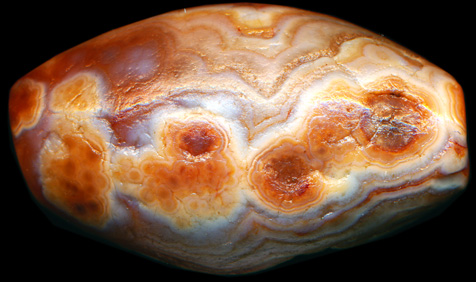
BB
15 -
30 * 18 * 15 mm
Where there is ruin, there is hope for
a treasure.
Rumi
|
|
Featured above is a remarkable
agate bead, a splendid testament to the intense theatrics of a
fiery volcanic birth. Its textured surface imparts an additional
dimension to the intricate patterns, enhancing the bead's
compelling depth and character.
|
|
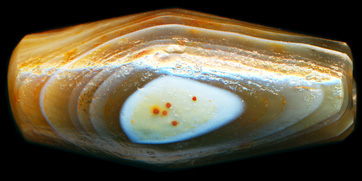
BB
16 -
23 * 10 mm
Beauty surrounds us.
Rumi
|
|
The cinnabar spots in the center of the eye are
within the Tibetan tradition referred to as blood spots.
When it comes to DZI-beads these blood spots are highly priced.
|
|
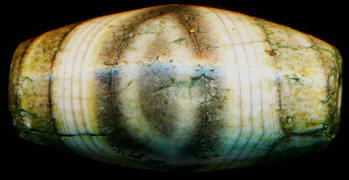
BB
17 -
21,5 * 11 mm
- SOLD
Suffering is a gift. In it is hidden
mercy.
Rumi
|
|
This greenish broken beauty looks like a cat-eye.
|
|
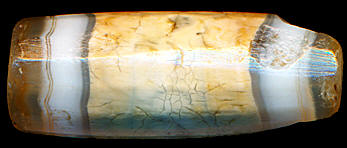
VBB
18 -
22 * 88 mm
You have to keep breaking your heart
until it opens.
Rumi
|
|
|
|
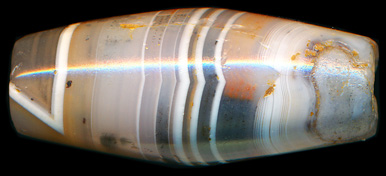
BB
19 -
24 * 10 mm
What hurts you, blesses you.
Darkness
is your candle.
Rumi
|
|
|
|
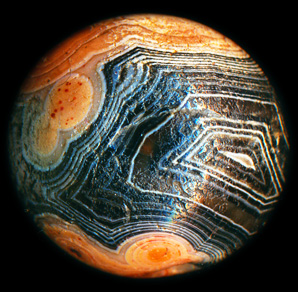
BB
20 -
17/18 mm
Don’t grieve. Anything you lose
comes round in another form.
Rumi
|
|
The spherical bead showcased above
is evocative of celestial bodies within a solar system.
Take note of the intriguing color and pattern variations - the
iron-red agate presents gentle, rounded motifs while the black
portion is characterized by striking white lines with crisp
delineations. Undeniably, this bead stands as a magnificent
example of natural artistry.
|
|
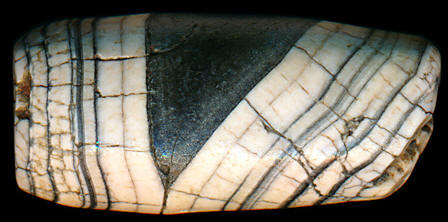
BB
21 -
28,5 * 13 * 11,5
mm
When you go
through a hard period,
When everything seems to oppose you,
... When you feel you cannot even bear one more minute,
NEVER GIVE UP!
Because it is the time and place that the course will divert!
Rumi
|
|
Use a loupe to
discover the hidden
micro world of ancient beads!
I highly recommend that anyone fortunate enough to
possess a truly remarkable and ancient bead should invest in a
quality loupe. This tool will allow you to delve into the bead's
microcosm, unveiling extraordinary patterns and hues previously
concealed from routine observation. Beads can bear striking
resemblance to miniature artworks, and a loupe allows you to
fully appreciate this minute grandeur.
|
|
*
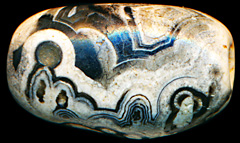
Click here for a super close up
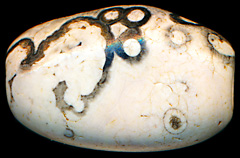
BB
22 -
15 * 9
mm
The cure for pain is in the pain.
Rumi
|
|
As illustrated above, a pattern
doesn't have to be symmetrical to evoke a sense of the sublime.
I am imperfect, and consequently, I find it challenging to see
my reflection in a flawless bead. When there is an intuitive
harmony between my flaws and the bead's imperfections, I find it
easier to let the bead's scars mend my own - not in the sense
that these blemishes vanish. Quite the opposite, actually: the
convergence of our flaws becomes an existential embrace of
a meta-modern Wabi-Sabi. In this understanding, I acknowledge that
it's my very scars that render me beautiful and alive. They
bestow upon me a unique identity and vivacity, making me a
distinct individual human being. Indeed, my scars define me, and
I am all the better for them.
|
|
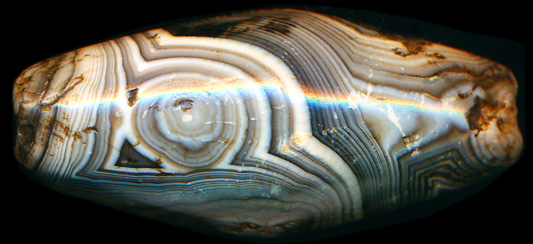
BB
23 -
33,5 * 16 * 14,5 mm
Start a huge, foolish project,
like Noah…
it makes absolutely no difference what people think of you.
Rumi
|
|
Embrace your Scars!
In many respects, Ancientbead.com serves as a meta-modern
therapeutic space! It offers tools for those unique individuals
who have discovered the enormous potential in fostering
gratitude for the so-called 'negative' events in their lives. As
C.G. Jung sagely pointed out years ago, we grow by bringing our
darkness into consciousness. This means acknowledging and
embracing our imperfections, our scars, as these are integral
parts of our journey. They shape us, refine us, and ultimately
add to our overall beauty, much like the beads we so admire.
They are reminders of our resilience, our strength, and our
capacity for growth. So let's be grateful for our scars, for
they have made us who we are today.
|
|
|
|
BROKEN BEAUTIES FROM THE INDUS VALLEY
Scars indeed come with age. Much like humans, beads
acquire wrinkles over time. As an observable fact, older
beads tend to exhibit more cracks than younger ones, an
embodiment of how the passage of time leaves its mark on
us and our cherished objects.
Due to their age, a large number of Indus beads bear
these signs of time, embodying a certain charming
vulnerability. The elongated bicone Indus beads, in
particular, are more susceptible to the ravages of time.
This vulnerability results from a combination of factors
including their age, length, and the nature of their
holes.
Being around 4000 years old, it is only natural for
these beads to show signs of wear and tear. These
specimens, however, are uniquely long and slender. This
physical attribute, combined with their unusually large
holes, renders them especially fragile, as demonstrated
in the image below. The stone becomes thin at the ends,
which makes these beads prone to fractures. Many
elongated bicone Indus beads share the same fate,
looking similar to the bead displayed below.
In spite of their cracks and chips, these beads hold an
indisputable allure. Their imperfections not only
narrate tales of their past, but also accentuate their
unique beauty, thus making them valuable pieces of
ancient artistry.
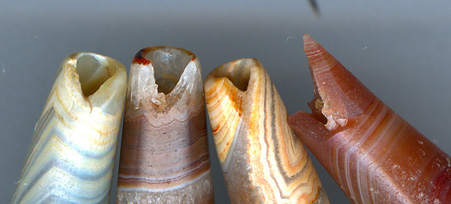
In these four Indus beads, the holes almost occupy a
greater volume than the actual stone material itself.
Remarkably, even in ancient times, these slender beads were held
in such high esteem that efforts were made to repair them when
they fractured. This process often involved cutting off the
damaged end. An example of such a repair can be observed in the
bead displayed below, where ancient patina or earth coloring is
visible on the surface of the repair.
This ancient practice of repair bears a testimony to the value
and significance these beads held in their societies. Despite
their fragility and the damages they sustained, these beads were
preserved and mended, adding yet another layer to their
historical and aesthetic richness. In fact, their very
imperfections and the marks of their restoration contribute
profoundly to their allure, making each bead a unique artifact
of human ingenuity and appreciation for beauty.
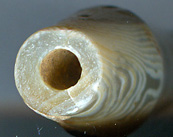
|
|
|
|

BB
24 -
65,5 * 13 * 9 mm
|
|
That is indeed fascinating. This bead, which is almost
4000 years old from the Indus civilization, was repaired
around 2000 years ago. The 'skin', or patina on the
flattened middle of the bead differs from the skin on
the rest of the bead. Although it's not evident in the
photo, when observed closely, the flattened middle part
of the bead exhibits a different patina, more akin to
the shine associated with
Mauryan-era artifacts.
This suggests that the bead was likely repaired during
the
Mauryan period, adding another layer of history to
this artifact. Such a revelation points to the continued
value and importance of these beads across different
periods and societies, further demonstrating their role
as not just objects of adornment, but as bearers of
cultural and historical narratives.
|
|
|
|

BB
25
- 35
* 9,5
mm
|
|
Indeed, the presence of a subtle red light at the
center of the bead's eye is captivating. It's possible that the
clear red light could be a reflection from minuscule precious
stones embedded within the agate itself, as it's not uncommon to
find gemstones such as rubies within agate formations. Click on
the image for a larger view to appreciate this interesting
feature.
Additionally, observe the fine, multi-colored layers present
within the brown parts of the bead. These elegant, thin lines
exhibit the remarkable craftsmanship and unique natural
formation of the agate, giving the bead its intricate and
charming aesthetic. It's details like these that truly make each
ancient bead a work of art and a testament to the sophisticated
beadwork of civilizations past.
|
|
|
|

BB 26
- (EIV 38) -
62
* 14 mm
|
|
The bead depicted above, despite being broken into two halves
and subsequently reassembled, showcases a seamless repair job so
skillfully executed that it's almost imperceptible. The bead is
like a vibrant canvas of myriad shades of green, creating a
palpable sense of lush vitality. It emanates an organic,
plant-like aura, rendering it reminiscent of a verdant grove.
The unique blend of colors and the expert restoration work
underscore the inherent, enduring beauty of the bead, a
testament to the incredible resilience and adaptable nature of
these fascinating ancient artifacts.
|
|
|
|

BB 27
- 28,5 * 8 mm
|
|
|
|
.jpg)
BB 28
- (EIV 26)
- 53 * 14,5 mm
|
|
A significant number of
Indus beads, like those illustrated above and below, are
entirely encased in calcification. This is likely
attributable to the fact that the Indus culture
practiced burial rituals, and over time, the beads
became calcified as a result of the decomposing body.
Memento Mori
In a way, these beads serve as profound symbols of
mortality. Their narrative is not for those easily
unsettled, but rather for those unafraid of time's
passage and inevitable changes, or for those wishing to
contemplate this inescapable truth. As the ancient
Romans cautioned, "Memento mori": Remember that you
are mortal.
This acceptance of mortality continues to resonate in
present-day India, where Sadhus, or holy men, often
choose graveyards and cremation grounds as their
preferred locations for spiritual practices. There's a
deeply ingrained understanding of the transience of
life, a sentiment echoed in these ancient, calcified
beads.
|
|
|
|
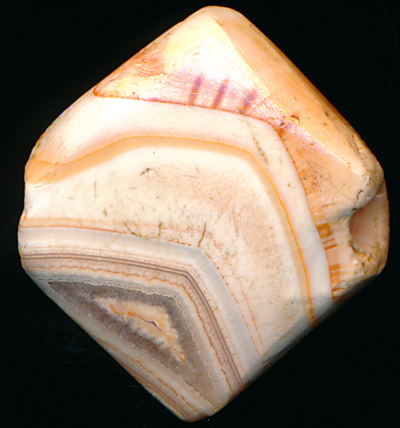
BB
29 -
26 * 23 * 7 mm
|
|
Embracing the Perfect Destruction
Our intrinsic yearning for
order, deeply embedded in our consciousness, encompasses
the chaos of Shiva within spiritual practices. Shiva,
the Hindu god of destruction, is often feared for the
perceived disorder and dissolution he represents. Yet,
without fully embracing this concept, we lose the cosmic
perspective that Shiva offers. His destruction is not an
end in itself, but a necessary precursor for creating
the order of the future. It's the unseen side of the
coin - Shiva's disruption and dissolution serve as the
fertile ground from which new life can spring. Thus,
Shiva is also revered as the God of fertility.
In this sense, everything - including these broken,
calcified beads - embodies the essence of being
perfectly imperfect. It's a testament to the beauty
found in the cycle of creation and destruction, a
universal dance where endings spark new beginnings, and
decay nourishes growth. It's a reminder to appreciate
not only the pristine and unblemished, but also the worn
and fractured, for in their imperfections, they reflect
the profound truth of our existence.
|
|
|
|
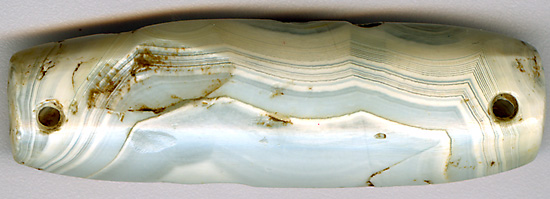
Top to bottom
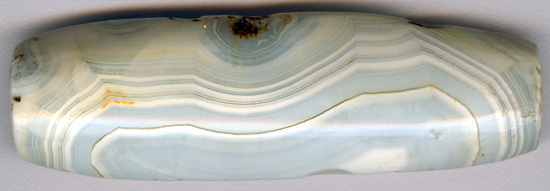 0 0
Front
BB
30 -
EIV 88 -
42 * 15 mm
|
|
The captivating, bluish
calcified bead displayed above boasts a unique shape. It
seems as though the bead maker worked in harmony with
the intrinsic patterns within the stone. One can surmise
that they meticulously examined the motifs within the
stone before deciding on the shape the bead would take.
Adding to this uniqueness, the holes are not
conventionally drilled horizontally from one end to the
other, rather they have been bored from the backside to
the end. Consequently, the front-facing design remains
undisturbed by perforations. Such an approach to
drilling was likely chosen for its practicality, as it
significantly reduces the effort and time involved. This
thoughtful approach underscores the remarkable
craftsmanship and detailed consideration that were
inherent in the creation of such pieces in ancient
times.
|
|
|
|

BB
31 -
EIV 30 - 34 * 7
mm
|
|
It is interesting to observe how the
Indus bead above and the three below all display eye
formations that have become more distinct due to the
calcification process.
|
|
|
|

BB
32 -
EIV 30 - 34 * 7
mm
|
|
These calcified Indus beads have super
large holes and hence they are very fragile at the end
points.
|
|
|
|

BB
33 -
EIV 31 -
33 *
9,5
mm
|
|
The bead above and several of the ones
below have been repaired by cutting of some part off the
ends.
|
|
|
|
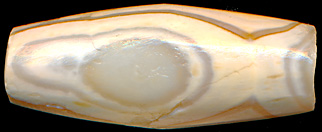
BB
34 -
EIV 118 -
22
* 8,5 mm
|
|
|
|

BB
35 - 32
* 8 mm
|
|
|
|

BB
36 -
(EIV 20)
- 44 * 12 mm
|
|
|
|
-

BB
37 -
|
|
|
|
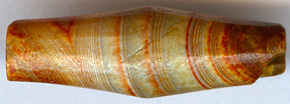
BB
38 -
EIV 34 -
24 * 8
mm
|
|
|
|
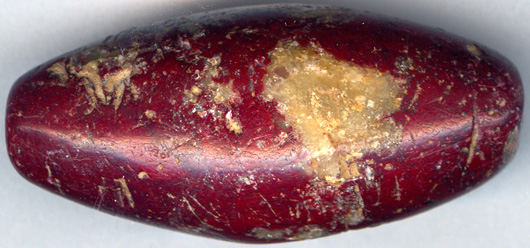
BB
39 -
EIV 43 -
45 * 19 mm
|
|
At first sight, one might perceive the bead above as
somewhat unappealing if not for the strikingly rich,
red-brown jasper hue it boasts. Yet, the allure of this
piece lies in its time-worn, scarred surface, as if
marked by the artistry of time itself. It stands akin to
a sculpture, carved not by the hands of a mortal
artisan, but shaped and engraved by the relentless flow
of time. The tactile record etched into the surface of
the bead bears a story that can awaken meaning within
its observer. Now, as you assume the role of this
observer, I put forth a question for your contemplation:
Are these etchings, these signatures of time, merely the
product of randomness or do they bear a more purposeful
intent?
|
|
|
|
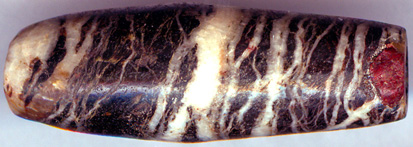
BB
40 -
EIV 54
- 35 * 11,5 mm
|
|
Here we can enjoy two banded jasper Indus
beads. Note that the swirling in jasper often is more
abrupt and irregular than in agate.
|
|
|
|
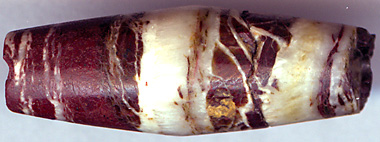
BB
41 -
EIV 55
- 31 * 11 mm
|
|
|
|
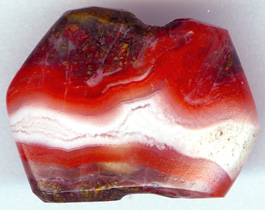
BB
42 -
EIV 83
- 22 * 16,5 * 7 mm
SOLD
|
|
Agate with such intense red color and
with white contrast bands is rare. That is most probably why in
ancient times, the lovers of beads found it worthwhile
to repair it at the endpoints.
|
|
|
|
|
|
|
|
|